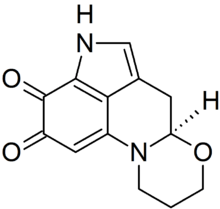Haematopodin
Haematopodin is the more stable breakdown product of Haematopodin B.[1] Both compounds are found in the mushroom Mycena haematopus, although haematopodin only occurs in trace amounts in fresh fruit bodies. Similar pigments (with the 1,3,4,5-tetrahydropyrrolo[4,3,2-de]quinoline structure), known as batzellins and damirones, have been found in sea sponges.[1] A chemical synthesis for haematopodin was reported in 1996. Key steps in the synthesis involved the addition of 3-[(2,4-dimethoxybenzyl)amino]-1-propanol to the indolo-6,7-quinone and cyclization of the resulting adduct with trifluoroacetic acid.[2]
 | |
| Names | |
|---|---|
| IUPAC name
6-oxa-2,11-diazatetracyclo[7.6.1.02,7.012,16]hexadeca-1(15),9,12(16)-triene-13,14-dione | |
| Identifiers | |
3D model (JSmol) |
|
| ChemSpider | |
PubChem CID |
|
| |
| |
| Properties | |
| C13H12N2O3 | |
| Molar mass | 244.250 g·mol−1 |
Except where otherwise noted, data are given for materials in their standard state (at 25 °C [77 °F], 100 kPa). | |
| Infobox references | |
References
- Baumann, C.; Bröckelmann, M.; Fugmann, B.; Steglich, W.; Sheldrick, W. S. (1993). "Pigments of fungi. 62. Haematopodin, an unusual pyrrologuinone derivative isolated from the fungus Mycena haematopus, Agaricales". Angewandte Chemie International Edition in English. 32 (7): 1087–89. doi:10.1002/anie.199310871.
- Hopmann, C.; Steglish, W. (1996). "Synthesis of haematopodin – A pigment from the mushroom Mycena haematopus (Basidiomycetes)". Liebigs Annalen. 1996 (7): 1117–20. doi:10.1002/jlac.15719960710.
This article is issued from Wikipedia. The text is licensed under Creative Commons - Attribution - Sharealike. Additional terms may apply for the media files.